Articles on australian tokens
This section lists articles on australian tokens. You can submit an article by contacting us.

Thomas Warburton, Iron & Zinc Spouting Works, Melbourne
The recently married Mr & Mrs Warburton arrived in Melbourne on New Year's Day 1853 on the Birmingham, according to Gardner. Warburton came to Australia on the same ship as Thomas Stokes, the diesinker who struck tokens for him and many other Australian businesses.
By Museums Victoria | Sunday, July 13, 2025
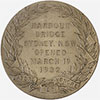
Sydney Harbour Bridge on Australian Medals
The Sydney Harbour Bridge is a few hundred thousand tonnes of steel and rock fashioned into a convenient and functional structure, has become a symbol of the nation and is photographed thousands of time each month.
By CAA | Friday, May 17, 2024
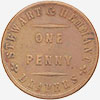
Stewart & Hemmant, Drapers, Brisbane
Alexander Stewart and William Hemmant operated drapery businesses in Brisbane and Rockhampton between the 1860s and the 1890s.
By Museums Victoria | Tuesday, May 14, 2024

Robison Bros. & Co., Victoria, Copper Works
James McFarlane Robison and Thomas Buchanan Campbell Robison came to Melbourne from Leith in Scotland. In 1854 they entered into partnership with Henry Dodds, also a Scot and founded this company at 103 Flinders Street West (Gardner). Their tokens were struck by Thomas Stokes in 1862.
By Museums Victoria | Tuesday, May 14, 2024
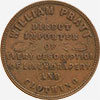
William Pratt, Draper, Christchurch
During the six years between 1843 and 1849 Pratt was quite a rover, having interests ranging from ship-building, growing potatoes in Tahiti, to farming. In 1848 we find him book-keeping in a general store in Wellington. Hearing the prospects of the new Church of England settlement in Canterbury, he moved to Port Cooper (later called Lyttleton), in 1849.
By Museums Victoria | Wednesday, June 21, 2023
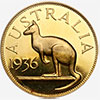
Unofficial Pattern Crown 1936
A major change in Australia's coinage followed the death of George V in 1936. It was decided to introduce all new designs for the reverse of the circulating coins with the exception of the sixpence. Originally the new coins were scheduled to coincide with the crowning of Edward VIII. Edward's portrait had been appearing on the watermark of our notes since the Legal Tender issues of 1933, while he was still the Prince of Wales.
By CAA | Friday, September 23, 2022

Joseph Moir, Economy House, Hobart
Moir issued one variety of token only. Richard Lord argues that Moir brought his tokens back with him from England in 1850, based, on the date shown on the token - 1850. This date has elsewhere been taken to be the date of the establishment of the store.
By Museums Victoria | Tuesday, September 20, 2022
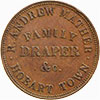
Robert Andrew Mather, Draper, Hobart
According to Gardner, Robert Andrew Mather was born and educated in Tasmania and managed the business from its foundation until his retirement in 1876, when his sons Robert and Thomas took control, changing the name of the store to Andrew Mather and Co.. R. Andrew died in 1884. Thomas retired from the business in 1894, and Robert was still managing the store in 1910, assisted by his two sons.
By Museums Victoria | Friday, January 28, 2022
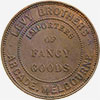
Levy Bros, Fancy Goods Importers, Melbourne
In 1852 the Levy brothers, Goodman, Nathaniel and Lewis, established a fancy goods warehouse and importing business in Lonsdale Street, Melbourne. Another brother, Alfred, was a travelling sales representative. When Queen's Arcade (the first arcade in Melbourne) was completed in 1853, they took one of the corner shops, soon adding another five or six shops as the business expanded.
By Museums Victoria | Wednesday, January 19, 2022

William Andrew Jarvey, Clothier & Pawnbroker, Hobart
William Andrew Jarvey arrived in Tasmania on 8 April 1844. He was immediately appointed a Police Constable, but nine days later he was transferred to the Water Police. In 1849 he obtained permission to marry Catherine Jane Shaw, a 25 year-old Irish convict. The following year he resigned his commission and became the Schoolmaster at the Cascades, outside Hobart.
By Museums Victoria | Wednesday, January 19, 2022

Macintosh & Degraves, Sawmills, Hobart
Peter Degraves (born Dover, England, 1778 and died the Cascades, Hobart Town, Tasmania, 31 December 1852), and Hugh Macintosh (born circa 1776, died the Cascades, Hobart Town, Tasmania, 24 December 1834). The two men were brothers-in-law.
By Museums Victoria | Wednesday, January 19, 2022
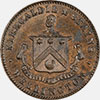
Kirkcaldie & Stains, Wellington
Kirkcaldie and Stains is a prestigious retail business. It is the Wellington equivalent of Melbourne's George's department store. it sells a range of expensive/prestigious brands for which they are the sole Wellington and/or New Zealand agents.
By Museums Victoria | Thursday, August 26, 2021

Alfred Hodgson - Outfitter & Tailor
The token issues of A.G. Hodgson cannot be fully understood without realising that he and his business neighbour John Andrew [whose drapery and outfitting business was located at 11 Lonsdale Street West] made their arrangements together. Both men ordered their tokens through a London agent named Coard.
By Museums Victoria | Tuesday, August 24, 2021
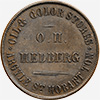
Olof Hilmer Hedberg, Whaler & Merchant, Hobart
Olof Hilmer Hedburg was born in the Swedish town of Uddevalla, on 14 April 1817. The first mention that numismatist Roger McNeice found of him in the public record was a listing as a small merchant in Sweden between 1835 and 1843. In 1838 he went to sea and eventually arrived in Hobart in 1844.
By Museums Victoria | Wednesday, January 27, 2021
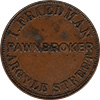
Isaac Friedman, Shop Keeper, Hobart
Friedman was still in business in 1857, as that was the year he issued his penny and halfpenny tokens. His business address then was Argyle Street, Hobart. His tokens were made in Birmingham by Heaton and Sons.
By Museums Victoria | Tuesday, January 26, 2021

William Froomes, Draper, Castlemaine
His token was one of the very large number struck by Thomas Stokes in 1862 and bears the details of his store on the obverse, with the Australian Arms on the reverse, along with the motto 'Advance Victoria'.
By Museums Victoria | Tuesday, January 26, 2021
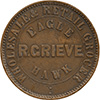
Robert Grieve, Wholesale & Retail Grocer, Eaglehawk
In 1862 Grieve was one of the many business men in the Castlemaine area to purchase tokens from Thomas Stokes. His tokens bore the details of his business, and on the reverse the Australian Arms with the motto Advance Victoria.
By Museums Victoria | Tuesday, January 26, 2021
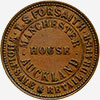
T.S. Forsaith - Merchant
T.S. Forsaith was born in England on July 18, 1814. He was educated at the Rev. Thomas Fancourt's Academy in Hoxton Square, London and was then apprenticed at a linen draper's shop in Croydon, Surrey.
By Museums Victoria | Tuesday, December 29, 2020

Edward Francis Dease, Draper, Launceston
He hung a golden fleece as the sign for his store. Dease issued a huge number of trade tokens. According to Roger McNeice in 1855 he imported 10,000 penny and halfpenny tokens, an event which made the local papers and must have had a big impact on the scarcity of small change to which the Launceston Examiner referred in its article.
By Museums Victoria | Saturday, December 19, 2020
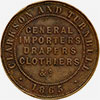
Clarkson & Turnbull, Drapers, Timaru
The firm of Clarkson and Turnbull was founded in 1863 at Timaru, a port to the south of Christchurch. The Principals were David Clarkson and Richard Turnbull. David Clarkson had previously been associated with two Christchurch businesses that issued trade tokens. His brother, Samuel Clarkson, issued tokens in 1857, advertising his business as an importer of building materials.
By Museums Victoria | Thursday, October 22, 2020
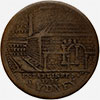
Tea Stores, Sydney, New South Wales
Chronology, from 1835 to 1857, of S. Peek and Co., Sydney Tea and Coffee Merchant, issuer of the Tea Stores Tokens.
By Museums Victoria | Saturday, June 13, 2020
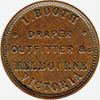
Isaac Booth & Co., Drapers, Melbourne
Numismatist Alfred Chitty observed that Booth's tokens do not have a street address or date, and suggusts they were issued in 1853 or 1854. Sharples has attributed the manufacture of Booth's penny token to Pope and Co. of London, observing that the reverse is the same as that on the 1857 De Carle and Co. tokens, also struck by that company. He estimates that the tokens were issued between 1850 and 1852, which tallies with Hope's assessment that the tokens were most likely issued in 1851.
By Museums Victoria | Wednesday, April 29, 2020

John Andrew & Co., Drapers, Melbourne
Born at Wick, Scotland, after his schooling John Andrew was apprenticed to the drapery trade in Glasgow and was later successful in his own drapery business in bustling Sauciehall Street. John migrated to Australia in 1853, arriving in Melbourne on 11 May, according to Gardner's biography.
By Museums Victoria | Sunday, April 19, 2020
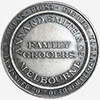
Annand, Smith & Co., Grocers, Melbourne
This company of Family Grocers of Collins Street, Melbourne, issued Australia's first circulating copper tokens, on 20 October 1849, as reported in The Argus. Although the token is not inscribed with a date, this report and an order for their manufacture discovered by researchers in Birmingham, England, confirm that they were issued before the great population boom of the gold rush.
By Museums Victoria | Sunday, April 19, 2020
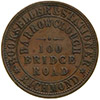
Myles Barrowclough, Bookseller & Teacher, Richmond
Myles Barrowclough was born at Mirfield in Yorkshire, England, on 11 August 1833. His father owned the Albert Woolen Mills at Morley. It seems likely that he is the twenty year-old Miles Barraclough who arrived in Victoria on the Jas Carson in October 1852. Although Myles Barrowclough was only 19 at the time this is the closest match on the index of immigrants to Melbourne for 20 years.
By Museums Victoria | Sunday, April 19, 2020
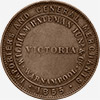
William Bateman Junior & Co, Importers & General Merchants, Warrnambool
William Bateman and his two sons William Junior and James arrived in Victoria from Yorkshire in 1853, bringing enough capital to start a store. The Bateman family had been involved in the woollen trade in Yorkshire prior to coming to Australia, and according to Turnbull, they brought a large volume of stock with them. Inward bound passenger lists held by the Public Records Office of Victoria show that eight passengers with the last name Bateman arrived on board the Prince Arthur in May that year.
By Museums Victoria | Sunday, April 19, 2020

George Petty, Butcher, Melbourne
Petty is said to have arrived as a boy in Melbourne, coming as a sailor on a ship that brought settlers to Port Phillip, but the date of his arrival is not known. The first trace of him is working in a butcher's shop on Elizabeth Street in 1853. By 1854 he was listed as the owner of a butchery at 105 Elizabeth Street.
By Museums Victoria | Tuesday, March 10, 2020
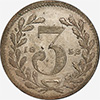
Hogarth, Erichsen & Co., Jewellers, Sydney
Julius Hogarth and Conrad Erichsen were partners in a Sydney jewellery firm that struck silver threepence and fourpence tokens bearing their own name, most bearing the date 1858, and others without dates, c.1860. Apparently Hogarth had diesinking skills and Erichsen was the technician.
By Museums Victoria | Monday, January 6, 2020

Adamson Watts McKechnie & Co., Melbourne, Victoria
The date 1 May 1855 is stamped on the penny and halfpenny tokens of Adamson, Watts, McKechnie & Co.. The week before this date a series of advertisements ran in the 'Trade Addresses' column of The Argus informing the public that 'The Bazzar' would be opening for business on 30 April 1855 (The Argus, Saturday April 28, 1855, p.6) at 11 Collins Street East, bringing together Mr. Adamson and the existing business of Watts and McKechnie & Co. So it would seem that the partners were ready to open a day earlier than they thought they would be when they ordered the tokens from token-maker Reginald Scaife of the Kangaroo Office.
By Museums Victoria | Monday, January 6, 2020
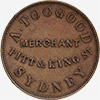
Alfred Toogood, Publican, Sydney, New South Wales
Alfred Toogood of Sydney issued penny tokens in 1855. He was listed as the publican at the Rainbow Tavern between 1855 and 1867. For the first listing his address was 76 Pitt Street. In the following year and for the majority of this period his address was the corner of Pitt and King Streets. In 1866 his address was given as 104 King Street, with stores at 52 York Street. Both the Sands Directory of Sydney for 1867, and Samson's National Directory of New South Wales, showed the tavern's address for 1867 - 1868 to be 223 Pitt Street.
By Museums Victoria | Wednesday, January 1, 2020

John Craven Thornthwaite, Token Maker & Medalist, Sydney
John Craven (J.C.) Thornthwaite was the first person to manufacture tokens and medals in Australia. He was born in England, the location variously recorded as County Cumberland or, according to information from his family, at St Batholomews Close, London, in 1820. At the age of 18 he was apprenticed to Slater Geoghegan of The Strand, Middlesex, as a stone, seal and gem engraver, for a period of six years.
By Museums Victoria | Friday, November 8, 2019
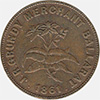
J.R. Grundy, Tobacco Merchant, Ballarat, Victoria
Grundy was, according to Gardner, an Englishman from near London. Victorian immigration records include one John R. Grundy, who arrived in Melbourne on the Ben Nevis in January 1855. He opened a tobacconist's shop in 1856, in Ballarat, 'and was the principal tobacconist in the town.' In Ballarat Directories dated 1856, 1862 and 1865-1866, his address is given as Main Road, Ballarat. Gardner gives his address as Bridge Road.
By Museums Victoria | Friday, November 8, 2019
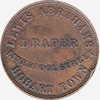
Lewis Abrahams, Draper, Hobart, Tasmania
Lewis Abrahams was certainly living in Hobart Town in 1835, records show that he was the occupier of a house and garden at 19 Bathurst Street and was in partnership with a certain H.C. Davis in a shop at 102 Liverpool Street. He was married in the Jewish Synagogue in December 1855.
By Museums Victoria | Wednesday, November 6, 2019
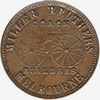
Miller Brothers, Coach Builders, Melbourne, Victoria
During the gold rush Victorian shopkeepers were permitted to issue their own copper coins, as long as they looked different from official currency. The story of the Miller Brothers, Coach Builders, is a story of family success cut short by tragedy.
By Museums Victoria | Tuesday, November 5, 2019
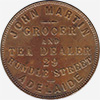
John Martin, Grocer & Tea Dealer, Adelaide, South Australia
Little is known of this John Martin. He was not the same John Martin who founded the eponymous department store and Adelaide landmark (that business was founded in 1866 under the name Peters and Martin, Drapers, at 94 Rundle Street).
By Museums Victoria | Tuesday, November 5, 2019
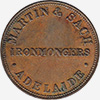
Martin & Sach, Ironmongers, Adelaide, South Australia
The earliest reference to Martin & Sach was found in the 1854 Royal South Australian Almanac, when they were listed as Ironmongers of Hindley Street. The same listing appeared the following year. In the 1858 edition the business was positioned more precisely, at 82 Hindley Street. This is the year identified in the Museum Victoria Catalogue as the most likely year for the issue of their tokens.
By Museums Victoria | Tuesday, November 5, 2019
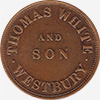
Thomas White & Son, Grocers, Westbury, Tasmania
The store from which Thomas White issued the White and Son tokens, the White House, is still located at the corner of Lonsdale Promenade and King Street in Westbury, Tasmania. McNeice's research found that he was living in Westbury as early as 1838, and that he founded his grocery business in 1845. A land grant giving the corner block to White is dated 4 November 1841.
By Museums Victoria | Tuesday, November 5, 2019

John Howell, Bookseller & Printer, Adelaide, South Australia
The earliest mention of a John Howell found in this survey was 1851, when a Clerk by that name was listed as residing in North Adelaide. The earliest mention of a bookseller by this name was in 1855 when he had a premises in Hindley Street and in Strangways Terrace, North Adelaide. This survey has not established whether or not these two listings refer to the same man.
By Museums Victoria | Tuesday, November 5, 2019

Iredale & Co., Sydney, Ironmongers, New South Wales
Lancelot Iredale, an emancipated convict, founded this ironmongery firm in 1820. He had been transported to New South Wales in 1816 at the age of 27. His initial address, 67 George Street South, became 372 George Street in a renumbering in 1844. The founder died in June 1848. A watercolour portrait of Lancelot, painted in 1830, is held by the State Library of New South Wales.
By Museums Victoria | Thursday, October 17, 2019
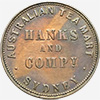
Hanks & Lloyd, Tea & Coffee Merchants, Sydney, New South Wales
Hanks and Lloyd was the first in a series of three trade token-issuing businesses owned by members of these two families. The following summary describes the series of businesses. John G. Hanks joined William Lloyd (probably William Fairclogh Lloyd - earlier identified in this text as A. Lloyd) to open a business at 319 George Street in 1853, which traded as the Australian Tea Mart.
By Museums Victoria | Thursday, October 17, 2019
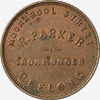
R. Parker, Ironmonger, Geelong, Victoria, Australia, circa 1857
Richard Parker arrived in Victoria in 1839 and established a general store in Elizabeth Street with a Mr. Boadle, the partnership disolved when Boadle left Melbourne. Parker then moved Collins Street and continued his business until selling out to Germain Nicholson in 1844, when he moved to Geelong and established an ironmongery store.
By Museums Victoria | Thursday, October 17, 2019

John Andrew & Co., Drapers, Melbourne, Victoria
Born at Wick, Scotland, after his schooling John Andrew was apprenticed to the drapery trade in Glasgow and was later successful in his own drapery business in bustling Sauciehall Street.
By Museums Victoria | Thursday, October 17, 2019
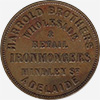
Harrold Brothers, Ironmongers, Adelaide, South Australia
Harrold Brothers, Ironmongers, issued penny tokens in 1858. From at least 1854 to 1871 Harrold Brothers occupied a number of premises on Hindley Street, Adelaide. The earliest reference located is from 1854, for D. & J. Harrold. The following year the brothers also advertised premises in Sturt Street. In 1857 their listing in the Royal South Australian Almanac gave their address as 127 Hindley Street.
By Museums Victoria | Thursday, October 17, 2019
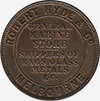
Robert Hyde & Co., Merchants, Melbourne, Victoria
Hyde's Marine Store was listed in a Melbourne directory for the first time in 1862, at 11 Albert Street East Melbourne. Between 1863 and 1865 he was listed as being in a partnership with Richard Hodgson (Hyde, Hodgson & Co.) in Albert Street, Emerald Hill. In 1866 and 1867 he was once again listed at 11 Albert Street East Melbourne. In 1868 his store was listed as a Rag Merchant's business at 120 Lonsdale Street West, before becoming a Marine Store for 1869 and 1870.
By Museums Victoria | Thursday, October 17, 2019

Warnock Bros., Drapers, Melbourne & Maldon, Victoria
The Public Records Office of Victoria index of Immigrants, 1852-1923 lists a Samuel Warnock as arriving in Victoria from Britain on board the Constance in December 1852. James is reported to have arrived in Victoria in 1854 at the age of 22. There is no mention of a James Warnock arriving up to and including 1858, so he must either have already been in Australia or not have been recorded as arriving on the passenger lists of the time.
By Museums Victoria | Thursday, October 17, 2019

The Dunrea Boys
The military transport ship 'H.M.S. Dunrea' was loaded with 2,542 so called 'enemy aliens' on 10 July, 1940 at Liverpool, England. Nearly all the passengers were political or racial internees, a majority of whom had fled to England from their homelands which had been occupied by Nazis and Facists. At that time, no chances of infiltration were being taken and they were treated as potential spies.
By AG | Wednesday, June 20, 2012
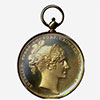
Medals and coins - Timeline and pictures
Medals and coins capture moments in history. They have been treasured by recipients, sought by collectors and now provide us with ways to look at the past. This timeline of more than 180 coins and medals tells many stories about people, places and events in Victoria's history. The subjects and designs reflect the social and political events that were considered important at the time.
By Museum Victoria | Thursday, November 22, 2007
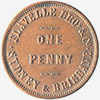
Australian Traders' Tokens 1849-1874 - Information Sheet
In the late 1840s there was a small change crisis in the Colony of New South Wales. It was perhaps most severely felt in Melbourne, the largest town in the Port Phillip District, and at that time still part of the Colony. In 1848 the Melbourne grocery firm Annand, Smith and Company, arranged for a private mint in Birmingham, England to make some copper pieces the same size as a penny coin. On one side they placed their name and business and on the other a figure of Britannia like the one on a real penny. When these arrived in 1849 they gave them out in change as pennies from their shop. There was outrage in the morning papers the next day demanding that the police and law courts take immediate action. However the tokens were not forgeries, they were not copies of real coins and clearly stated what company had issued them. Recently too, in 1811, private tokens had been issued in Britain, so no action was taken.
By Museums Victoria | Friday, April 1, 2005



